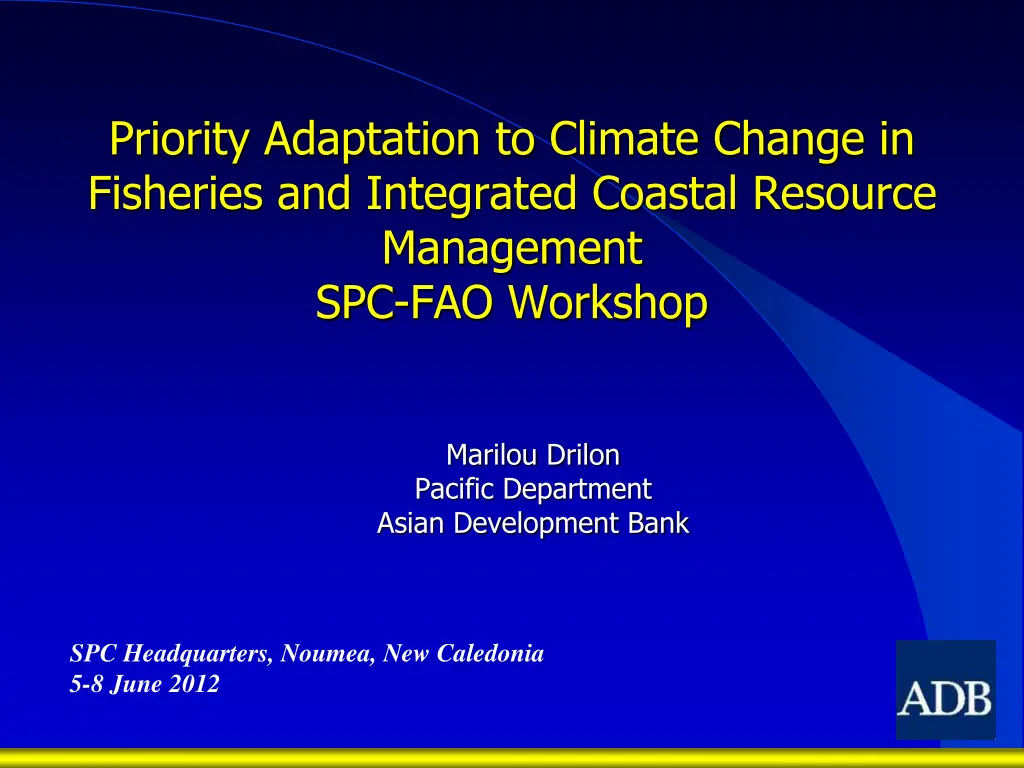
Climate Change Adaptation in Fisheries and Coastal Management
Explore the priority adaptation strategies for climate change in fisheries and integrated coastal resource management discussed at the SPC-FAO workshop. Dive into initiatives like the Coral Triangle Plan of Action and Pacific country priorities focusing on sustainable development and resilience-building.
Download Presentation

Please find below an Image/Link to download the presentation.
The content on the website is provided AS IS for your information and personal use only. It may not be sold, licensed, or shared on other websites without obtaining consent from the author. If you encounter any issues during the download, it is possible that the publisher has removed the file from their server.
You are allowed to download the files provided on this website for personal or commercial use, subject to the condition that they are used lawfully. All files are the property of their respective owners.
The content on the website is provided AS IS for your information and personal use only. It may not be sold, licensed, or shared on other websites without obtaining consent from the author.
E N D
Presentation Transcript
Priority Adaptation to Climate Change in Fisheries and Integrated Coastal Resource Management SPC-FAO Workshop Marilou Drilon Pacific Department Asian Development Bank SPC Headquarters, Noumea, New Caledonia 5-8 June 2012
Outline Coral Triangle Initiative (CTI) Regional Plan of Action Coral Triangle in the Pacific Impact and Outcome Country Priorities Climate Change Adaptation Financing Conclusion
CTI Regional Plan of Action I.Priority seascapes designated and effectively managed Priority seascapes designated with investment plans completed and sequenced. Marine and coastal resources within all Priority Seascapes are being sustainably managed. II. Ecosystem approach to fisheries management (EAFM) and other marine resources fully applied strong legislative, policy and regulatory frameworks in place for achieving EAFM Improved income, livelihoods and food security of people in coastal communities across the region through a sustainable coastal fisheries and poverty reduction initiative ( COASTFISH ). By 2020, effective measures in place to ensure exploitation of shared tuna stocks is sustainable, with tuna spawning areas and juvenile growth stages adequately protected. A more effective management a more sustainable trade in live-reef fish (LRF) and reef- based ornamentals achieved.
CTI Regional Plan of Action III. Marine protected areas established and effectively managed A region-wide Coral Triangle MPA System (CTMPAS) in place and fully functional. IV. Strengthened Capacity in climate change adaptation Region-wide early action plan for climate adaptation for the near-shore marine and coastal environment developed. Networked national centers of excellence on climate change adaptation for marine and coastal environments are established and in full operation V. Threatened species status improved By 2020, improved status of sharks, sea turtles, marine mammals and other identified threatened species.
Coral Triangle in the Pacific Impact and Outcome I. Ensure food security II. Build climate change resilience III. Halting the decline in ecosystem productivity IV. Sustainable local community development
Pacific Countries Priorities I. Fiji: Locally Managed Marine Area community based management in Ra province II. PNG: Managing land-based threats and identifying livelihood opportunities and EAFM in Manus Island III. Solomon Islands: ICRM & EAFM witin community based program in Malaita and Isabel provinces IV. Timor Leste: ICRM & EAFM in Atauro Island & Batugede V. Vanuatu: ICRM & EAFM in coastal communities
Priorities with funding gaps I. Regional Funding Priorities Study on welfare impacts of climate change across CT Social and natural impacts of climate change identified and database Solomon Islands II. Help coastal communities adapt to climate change Inshore fisheries mapping activities Timor Leste III. Mangrove rehab as climate adaptation tool Climate change information center
The continuum of adaptation financing From vulnerability to Impacts Addressing the drivers of vulnerability Building response capacity Managing climate risk Confronting climate change (poverty, non- climatic factors) (building systems for problem solving) (incorporating climate information into decision making) (addressing impacts exclusively associated with climate) Traditional development funding New and additional adaptation funding
Funding Mechanisms for Adaptations to Climate Change Pilot Program for Climate Resilence - to address capacity, knowledge and resources constraints to achieve climate resilience. Climate Investment Fund - $75m grant over a five year period ADB -- PPCR activities in Tonga and PNG, & regional level World Bank -- PPCR activities in Samoa Country level : Samoa ($25m grant), Tonga ($15m grant) & PNG ($25m) Region-wide interventions covering 14 Pacific DMCs ($10m) Australia: AusAID and Dept. of Climate Change & Energy Efficiency UNDP, EU, DFID Implementing partners: SPREP, SPC, FFA, PIFS
Conclusion ADB investments and technical assistance on climate change will double from $2.5B annually to $5B by 2020 Improve links of current initiatives to past or on-going investments and support programs - Country partneships strategies; business plans - Disaster risk reduction strategies and frameworks - National adaptation plans Enhance integration of CCA & DRR and mainstreaming of these into development processes and roadmaps
